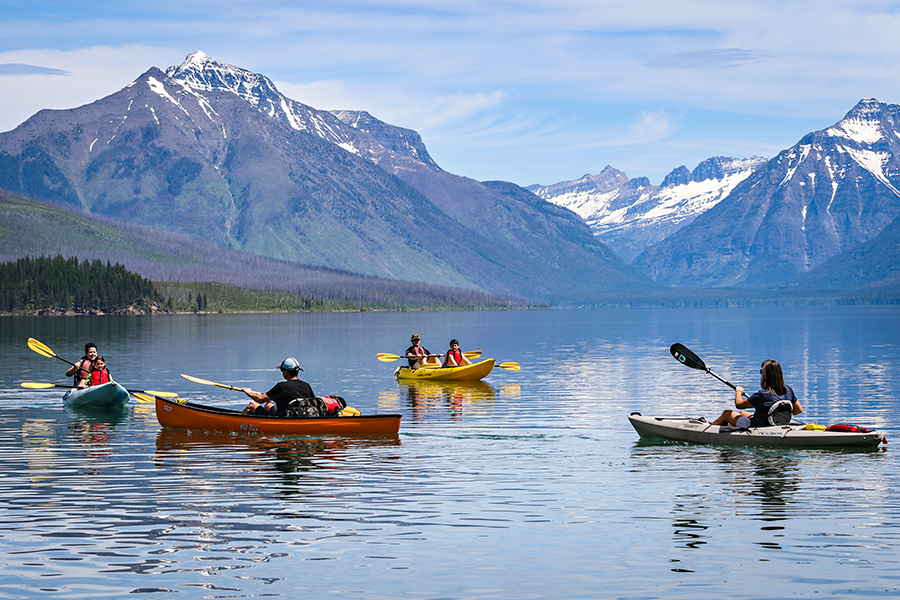All three lanes to enter Glacier National Park over the weekend were packed with the usual Fourth of July surge in visitations. Despite the flux, cars were swiftly waved past the kiosks without the usual stop-and-start that usually accompanies paying entrants.
The COVID-19 pandemic has led to a drop in park revenue at this point in the 2020 season, in large part from the two-month closure that left the park bereft of visitors in April and May.
The park doesn’t collect entry fees at the gate during those months in normal years, instead relying on visitors “on their honor” to pay online or via a dropbox.
This year, that is supposed to be the new normal, with park officials considering it too risky to staff the attendant’s booths full time due to contact with so many people.
“We are collecting fees other ways,” said Glacier National Park spokesperson Gina Kerzman. But “we’re really not making a big deal about it. We probably should have something posted on the front gate, but we’re not pushing it.”
Just before the March 27 closure of the park, Interior Secretary David Bernhardt had announced that entry fees to national parks across the country would be waived to encourage people to use the outdoors as safe escapes during the pandemic.
For Glacier Park, revenue from entry fees is vital to maintaining operations within the park. Of the revenue collected at the gate, 80% stays in the park and more than half of the collected money goes directly towards deferred maintenance projects in the park.
Kerzman said that the impact will be felt strongly next year, and projects will have to be prioritized in order to make up for the lack of funds.
The latest estimate of deferred maintenance in Glacier Park stands at $131 million, with roadway projects and structure upkeep making up a majority of projects.
There is some hope with the recent passage of the Great American Outdoors Act through the Senate in June. The legislation provides historic levels of funding for public lands agencies, with $9.5 billion earmarked for deferred maintenance across the National Park Service, Bureau of Land Management, Bureau of Indian Education and other government-managed lands. This is the largest public lands investment in more than 50 years and while it won’t allow the Park Service to fully catch up on projects within the parks, it will make a sizeable dent.
Until the legislation passes the House and begins disseminating to the various agencies, however, Glacier National Park will continue losing revenue.
Visitor access for the 2020 season will be limited, after the recent decision by the Blackfeet Nation to ban travel through the east entrances of the park for the year.
Kerzman said the park is still figuring out the logistics of managing the full park through a single entrance. With visitors restricted to the west entrance, officials are brainstorming how to turn cars around on the east side of the park and handle added crowding at Logan Pass.
In addition, the park will not be running shuttles or Red Bus Tours along Going-to-the-Sun Road as long as social distancing guidelines are in place. Currently, vehicle access is still limited to Avalanche Creek. Hikers and bikers are allowed to continue up to Logan Pass.
Enough tourists pack the 16 miles of open road every day that the park continuously closes and opens sections of road and parking lots to handle the traffic
“People don’t have the options they normally do so it puts extra pressure on destinations like the McDonald parking lot and Avalanche parking lot,” said Kerzman.
Several campgrounds are being utilized as extra parking facilities, and official are debating whether the alternate usage should continue all season. Only two campgrounds, St. Mary and Apgar, are being considered for regular use later in July.
Kerzman said that access to popular sites in the eastern half of the park such as Many Glacier might be accessible via foot later in the year, but so far no passage across the divide is allowed.
“As far as the eastern half of the park is concerned, we’re in a holding pattern,” said Kerzman, adding that even thru hikers along the Continental Divide Trail are currently barred from passing through the park.
Park officials continue to emphasize safety as the priority during reopening, stating that if they feel like it’s a hazard for the park to remain open, “we need to be ready to close down again.”
A decision that drastic would take collaborative input from the park, the county, the state and the tribe, and Kerzman said there is no indication things will get that far.
“For now we just hope we can give people as many options as possible to get outside and take advantage of Glacier,” said Kerzman. “Mountains are still mountains, rivers are still rivers, and they can get a sense of stability where things aren’t so crazy.”
